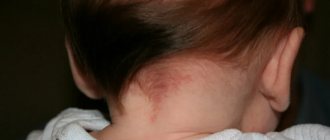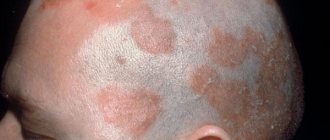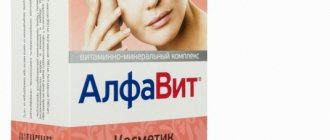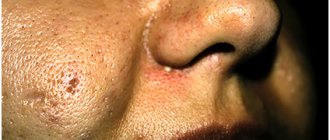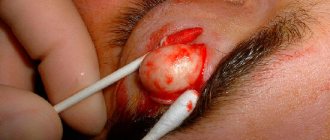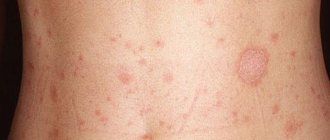What does redness under the breasts mean? Let's find out in this article.
The condition of a person’s skin is an indicator of painful or pathological processes occurring in the body. Neoplasms or rashes in the chest area may indicate the development of various pathologies, which are determined based on the size, color and sensitivity of the rash.
The presence of red spots under the breasts can in some cases indicate an infection in the breast tissue, which leads to swelling, tenderness and swelling. The spots are easily visualized and palpated.
Diaper rash: description and causes
Diaper rash in the submammary space refers to an inflammatory process localized in the skin folds. Most often, diaper rash occurs in the female population during the hot season. It is during this period that excess moisture accumulates under the breasts, which provokes the active reproduction of pathogenic microorganisms. Friction from clothing can also lead to diaper rash.
Red spots under the breasts occur against the background of infectious, fungal and other pathological processes. The risk of diaper rash is especially high in the presence of scratches, abrasions and wounds. The following causes of diaper rash under the breasts are identified:
- Excess body weight.
- Hyperhidrosis.
- Violation of personal hygiene rules.
- Large chest volume.
- Allergic reaction.
- Wearing uncomfortable underwear that rubs the skin.
- Diabetes.
- Dermatological diseases of infectious nature.
The pathological process is activated as a result of careless drying of the skin and poor ventilation in the chest area. Sometimes redness can be caused by taking antibiotics.
What to do if the skin under the breasts irritates
See your doctor to find out the cause of the irritation.
- Take medications prescribed by your doctor.
- Supplement treatment with appropriate hygiene measures.
- For mild redness that does not cause discomfort, home remedies can be used. A pharmaceutical cream without antibiotics, as well as proven folk remedies, can help.
Home remedies include:
Choose underwear without sharp elements, from natural, high-quality fabrics that provide good support.
- The affected area should be washed at least twice a day without using soap.
- After washing your face, apply an anti-inflammatory cream to the affected area.
- If diaper rash occurs, use baby powder to combat it.
- Baths with the addition of decoctions of oak, string, chamomile, which have anti-inflammatory properties.
- Wear comfortable clothes made from natural materials that breathe well.
- Eliminates the risk of contact with allergens.
- Change your diet to be healthier and more varied.
- If you need medications, your doctor will prescribe them depending on your condition.
Severe aseptic dermatitis should be treated by wiping the problem area with antiseptic solutions. The problem occurs when a woman is pregnant, breastfeeding, or when irritation occurs due to tight underwear. In this case, it will be safe to use an aqueous solution of furatsilin, miramistin and chlorhexidine. Therapy is carried out for at least 2 days.
Aseptic dermatitis
Drug treatment is determined depending on the cause of irritation in the chest area. If itching and redness are caused by external irritants, Bepanten ointment will help. When the skin becomes red due to mites, permethrin benzyl benzoate will help. Ointments and gels are used in courses of 2-4 days.
Drug therapy
External causes of irritation:
External causal factors
Mechanical friction.
- Failure to comply with hygiene rules.
- Food, plant or animal allergies.
- Allergy to household chemicals and cosmetics.
- Fungal diseases and breastfeeding.
- Choosing the wrong underwear or clothing.
- Eliminating these factors will help prevent the problem and eliminate it, unless we are talking about pathologies such as mastopathy or internal infections.
They will have to be treated by a doctor; during the procedure you cannot sunbathe or visit a solarium.
If you have applied home care, and the nipple, areola or skin under the breast continues to itch, burn, hurt and become red, you should consult a specialist. Only a specialist can determine exactly why the spot appeared and prescribe competent, effective treatment.
When you need a doctor's help
Irritation is not necessarily a symptom of a serious pathology. Often this is a sign that the girl has chosen inappropriate clothing, diet or care. If there are no serious irritations, they can be treated at home. If severe itching and redness occurs, you should consult a doctor for an accurate diagnosis and prescription of medications.
What does it look like?
Diaper rash under the breasts resembles psoriasis, eczema and dermatitis in appearance. Therefore, an important stage of the examination is differential diagnosis. In a laboratory, material is collected to determine the sensitivity of pathogens to antibiotics. Next, your blood sugar levels are checked to rule out diabetes, which is often accompanied by hyperhidrosis.
Diaper rash under the mammary glands in older women
The skin of older women loses elasticity, becomes sensitive, dry, and thins. It rubs and cracks easily, and then takes a long time to heal. The cause of diaper rash under the breasts in older women can be rubbing even with high-quality fabric, so it is necessary to constantly inspect this area. Age-related changes in women's skin lead to a number of features in the treatment of diaper rash:
- The material of the bra during therapy should be soft and breathable.
- Dry skin should be compensated by increased use of moisturizing creams with a healing effect. Appropriate baby creams will also work.
- It is recommended to wipe the inflamed areas with decoctions of oak and chamomile, followed by application of zinc ointments or powders.
Pashkova Alla Valerievna
Obstetrician-gynecologist, candidate of medical sciences.
Ask a Question
Inflammation of the skin under the breasts in older women tends to become chronic, so it is important to monitor the condition of the folds under the mammary glands and promptly treat the disease.
Heat rash: risk factors
Overactivity of the sweat glands can lead to irritation under the breasts in both sexes. Miliaria is characterized by burning and itching, as well as redness of the skin and other signs. Miliaria does not go away on its own and requires medical treatment with local remedies.
Everyone knows what a child’s heat rash looks like. The same spots occur in women.
They are formed for the following reasons:
- Anatomical features of the female breast structure. If air access to the chest is limited, sweat accumulates in the submammary area. With hyperhidrosis, skin infections can occur.
- Friction while wearing a bra. This is the most common cause of stains. Due to friction, injuries to the dermis occur, which leads to skin irritation and heat rash in women.
- Wearing unnatural, synthetic fabrics, as well as very tight clothing. Artificial fabrics are not ventilated, which leads to excessive sweating.
- Skin lesions by staphylococcus and streptococcus.
- Using powders and detergents that irritate the skin.
- Poor quality skin care products.
In some cases, prickly heat in the submammary area occurs due to a malfunction in the functioning of the endocrine system and metabolic processes.
When does it progress?
Red spots under the breasts progress under the following conditions:
- Damage to the skin.
- High intensity physical activity.
- Gaining body weight.
- Increased temperature, fever.
- Neglect of personal hygiene rules.
- Diabetes.
- Nervous system disorders.
- State of stress.
What a sweat rash looks like should be found out in advance. It causes discomfort and requires elimination of the cause that provoked this pathology. If left untreated, heat rash can develop into a more serious condition such as eczema.
Acne on the chest: prerequisites for its appearance
Medical practice shows that acne appears in the chest, back and neck no less often than on the face. However, the chest area is usually hidden from prying eyes, so patients rarely consult dermatologists about rashes in this area. Many people hope that the rash will go away on its own, but this is the wrong approach, since acne can signal a serious pathological process in the body.
There are several main factors that can lead to itching under the breasts and rash:
- Blockage of the ducts responsible for removing sweat and fat. In this case, pimples are white, small in size and affect large areas of the skin.
- Allergic reaction to the use of perfume or cosmetics, detergents.
- Impaired thermoregulation. Hypothermia or overheating as a result of wearing clothes made of synthetic materials that do not allow air to pass through and irritate the skin. Pimples are red in color. Impaired thermoregulation is typical for people with excess body weight.
- Hormonal imbalances. The secretion of sebum by the skin promotes natural hydration of the epidermis and strengthens local immunity. Changes in hormonal levels, provoked by puberty, menstruation, pregnancy or endocrine pathologies, lead to an imbalance in the skin and, accordingly, the appearance of purulent acne under the breasts.
- Endometriosis. In some cases, women with this pathology develop acne in the chest area, but after treatment the problem is eliminated.
- Frequently being under stress. Pimples on the chest may appear due to nervousness. In this case, the rash goes away along with the improvement of the emotional background.
- Immunodeficiency. In this case, any rash on the body poses a serious danger, as it negatively affects the general condition of the patient and also increases the risk of developing sepsis.
- Diabetes. Acne on the chest appears in cases of severe diabetes in an uncompensated form.
- Unbalanced diet, allergies to certain foods.
Why does severe irritation occur in the chest area?
Excessive redness is a sign of skin interaction with a strong allergen, which appears several hours after contact. The following factors provoke a severe allergic reaction:
- Contact with an animal to which the girl is allergic.
- Eating unusual foods.
- Underwear or clothing made of synthetic fabric.
- A new bra worn for the first time can cause skin irritation.
If a woman ignores the slight redness and small rash, the likelihood of severe irritation increases. Redness can be aggravated by self-medication, poorly treated dermatosis or mycosis.
If irritation is not treated, an infiltrate will form in the affected area. Its discharge is transparent or white and the smell is extremely unpleasant. You will already need to be treated with antibiotics, which are prescribed only by a highly specialized doctor. Such drugs are not sold in pharmacies without a prescription.
Rash: causes and characteristics of rashes
A rash in the chest area refers to irritation and redness of the skin, accompanied by itching, soreness and other discomfort. In some cases, a rash in the form of blisters and peeling may also appear.
The causes of red spots under the breasts can be a wide variety of dermatological problems and diseases. However, the nature of the rash will differ in each individual case. The main causes of the rash are as follows:
- Miliaria as a result of increased sweating during the hot season. Blisters are accompanied by itching and are formed due to blockage of the glands responsible for the production of sweat. At the initial stage, the rash consists of small plaques that eventually merge into blisters. As a rule, the rash goes away on its own after a few days. The affected skin should be regularly dried and ventilated. What else could a rash under the breasts mean?
- Dermatological candidiasis. It is a fungal infection. Yeasts are activated in conditions of humidity and high temperature. Candidiasis on the skin is characterized by the appearance of bright red spots. Sometimes the affected areas of the skin may become crusty or wet. If there is glucose in the patient's sweat, the process of fungal reproduction accelerates. Patients with diabetes are at risk.
- Scabies. A highly contagious disease. The causative agent of scabies is a special scabies mite. The parasite moves in the upper layers of the skin and causes an itchy rash. The spots are numerous and have jagged, clear edges. The areas most commonly affected are the armpits, wrists, groin and nipple areas, as well as the inframammary folds.
- Bacterial damage. Most often, the appearance of a rash is caused by Staphylococcus aureus. In this case, in addition to redness and itching, ulcers appear. The infection quickly affects healthy areas of the skin.
- Allergy. This rash under the breasts may appear when wearing certain artificial materials or using harsh detergents.
- Mammary cancer. As cancer pathology progresses, it can lead to death. Signs of a neoplasm in the mammary gland may include a rash accompanied by pain and fever. The rash can affect one or both breasts. The mammary glands require special attention from women. Experts recommend visiting a mammologist several times a year, especially if you are predisposed to cancer.
Diagnosis and treatment
Severe, persistent itching, redness or rash in the crease under the breast is a reason to consult a dermatologist as soon as possible. In very rare cases, when cancer is suspected, women are referred to the breast department.
To make an accurate diagnosis and prescribe effective treatment, you will need to perform the following steps:
- Thorough examination of the patient and interview;
- laboratory blood and urine tests;
- Taking a biopsy from the affected area for a BAC culture to determine the pathogen causing the disease;
- blood sugar test.
Before each treatment, for example, applying ointments (except for scraping the BAC), the skin should be thoroughly cleaned of moisture, crusts and other contaminants. To do this, use regular soap (preferably hypoallergenic, odorless), after which the skin is washed with a weak solution of manganese or furacillin. After all cleaning and disinfection activities, the skin should be dried with one soft towel. The skin should not be mechanically irritated: the towel should only be used for staining and not rub the affected area.
Each specific clinical case requires an individual approach and treatment, taking into account all the nuances. A common feature of all treatment courses is the use of special oils (for example, sea buckthorn) and drying, disinfecting ointments based on zinc:
- Taimur paste,
- Desitin,
- Linin.
The following treatment regimen is also often used: treating the skin with a solution of zinc, copper or resorcinol + applying Lorinden C or Locacorten.
Clotrimazole is prescribed for fungal skin lesions, and for ulcerative-corrosive defects - deamination ointment.
In the fight against advanced diaper rash, Levomekol and Levosil ointments, as well as tar ointments, are widely used.
In order not to irritate the affected areas of the skin, the product does not need to be rubbed in; it is better to use it carefully and let it absorb.
Alternative medicine to combat itching and irritation under the breasts
To avoid unwanted allergic reactions, it is recommended to discuss any folk remedies with your doctor in advance. One of the most “authoritative” remedies for itching and rashes under the breasts:
- Cornstarch or baby talc (do not wet).
- Rub the injured area with oak bark infusion. For 1 liter of boiling water, take no more than 3 tablespoons of crushed bark, let the product infuse for 2 hours.
- If you feel unbearable itching under your breasts, diluting boric acid, lemon juice and apple cider vinegar will help eliminate the discomfort.
- An infusion of chamomile, calendula, string, sage and mint flowers will help soothe irritated skin. This remedy can be used an unlimited number of times a day.
If the usual herbal medicine procedure does not bring positive results, you should seek professional advice from a doctor and use stronger drugs. The sooner we find the true cause of itching and rash, the less likely complications are.
Treatment
Drug treatment involves the use of various topical preparations, that is, ointments, creams and gels. When treating skin rashes, drugs must have a pronounced antiseptic and antibacterial effect. The most effective remedies for eliminating rashes in the submammary area are considered to be Fukortsin, manganese and methylene blue. Before starting treatment, it is important to consult a doctor who will clarify the diagnosis and prescribe a suitable remedy. In addition, you must carefully read the instructions for any drug that you plan to apply to the skin, and also conduct a test for the sensitivity of the epidermis to its components. Diaper rash remedy can be purchased at any pharmacy.
When you need to quickly dry the skin and remove excess moisture, medications and powders are prescribed, which also promote wound healing. This could be, for example, “Bepanten” or “D-panthenol”. If the rash is accompanied by severe itching, antihistamines are prescribed, both orally and for topical use. Antibacterial agents are prescribed in cases where pimples with purulent contents appear on the skin.
Antibacterial agents
The most popular antibacterial ointments for skin are:
- "Levomekol". Used for burns, ulcers and deep skin lesions. Increases local immunity.
- "Bactroban". Effectively fights staphylococci, and is also active against a strain resistant to methicillin.
- "Gentaxan". A wound-healing, antibacterial drug that eliminates ulcers and various skin lesions.
- "Baneotsin". An antibiotic that quickly and effectively eliminates ulcers and the inflammatory process.
- "Fastin." Antibacterial ointment for the skin, relieves inflammation and eliminates pus. Suitable for the treatment of burn skin lesions.
- "Metrogil" is intended for the treatment of acne and pimples. The drug has antimicrobial and antiprotozoal effects.
- "Klenzit." It also has a pronounced antibacterial effect and is suitable for treating rashes and redness, including in the area under the breasts.
- "Fusiderma". Relieves inflammation and has an anti-allergenic effect. Suitable for the treatment of dermatitis of various origins.
Treatment of irritation under the breasts must be carried out under the supervision of the attending physician, following all the recommendations of a specialist.
How to treat irritation under the breasts with medication?
Drug treatment for irritation under the breasts should be prescribed exclusively by a doctor after receiving the results of laboratory tests. Self-medication is quite dangerous, because it is fraught with progression of the disease. It is best to consider drug therapy in the context of the causative factors causing this pathology.
Infection with pathogenic bacteria
Infectious dermatitis under the breast is usually accompanied by redness, itching, rash and the appearance of a foul-smelling infiltrate. To treat the disease, antibiotic ointments and drying emulsions are used. Among antibacterial agents, drugs that contain:
- erythromycin;
- tetracycline;
- chloramphenicol (chloramphenicol);
- lincomycin;
- gentomycin.
Pashkova Alla Valerievna
Obstetrician-gynecologist, candidate of medical sciences.
Ask a Question
At your first visit to the doctor, it is recommended to take a microflora sensitivity test to antibiotics, so that if the initially prescribed drug is ineffective, you will know what to replace it with. Medicines are most often used topically, but if the affected area is large, oral and intramuscular medications can also be prescribed.
Fungal skin infections
Fungal infections are no less dangerous than bacterial ones. Treatment of skin mycoses is carried out locally with ointments containing the following ingredients:
- bifonazole;
- naftifine hydrochloride;
- clotrimazole;
- Terbinafine hydrochloride.
The method and duration of therapy depends on the effectiveness of treatment and the recommendations specified in the instructions for the drug. Fungal diseases can occur due to weakened immunity or intensive antibiotic therapy.
In case of mycoses, it is important to maintain hygiene of all parts of the body, especially the feet and hands, so as not to transfer the fungus to them.
Aseptic dermatitis
Redness and irritation of the skin in the chest fold can occur from rubbing with a bra, excessive sweating, or poor hygiene.
Rubbing often occurs when the mammary glands grow rapidly during pregnancy and breastfeeding. Drug treatment of such dermatitis comes down to wiping the problem area with antiseptic solutions, but only if there is a danger of infection. Popular drugs are solutions of furatsilin, hexetidine and miramistin, which are sold under many commercial names. It is enough to use them for two days.
Additionally, local remedies are prescribed to restore microdamage to the skin and diaper rash. For this, ointments with a wound-healing and regenerating effect are used: bepanthen, panthenol, pantoderm and others.
The main emphasis in the treatment of aseptic dermatitis under the breast is on hygiene procedures.
Question to the expert
I developed irritation between my breasts, small red spots and flaking around the edges. What remedy can be used to remove this skin disease?
The symptoms you describe may be characteristic of seborrhea, atopic dermatitis and other diseases. If the irritation does not disappear after 3-4 days of careful hygienic care on its own, then contact a specialist.
Local allergic dermatitis under the breasts
Allergic dermatitis in the area of the pectoral fold occurs infrequently. Before treatment, it is necessary to identify the allergen and minimize contact with it. Drug treatment is limited to taking local and systemic antiallergic drugs.
In mild cases, with minor rashes and itching, non-hormonal ointments are used: Fenistil, Psilo-Balm, Ketocin and their analogues. At the same time, it is possible to prescribe oral antihistamines - edema, suprastin, suprastin, citrine.
For severe itching, hives and burning, hormonal ointments are indicated: Dermasan, hydrocortisone, Advantan, Coderm. If an infection is suspected, a combined hormonal ointment with antibiotics is used: Levomekol, Kremgen, Skin-cap and others.
Scabies mite in the chest fold
The fold under the mammary gland is one of the typical places for scabies mite parasitism. The disease manifests itself as frequently located red nodules and severe itching, intensifying in the evening and at night.
Treatment is only local with the use of antiparasitic drugs containing the following substances:
- benzyl benzoate;
- permethrin;
- esdepalletrin;
- piperonyl butoxide.
Medicines are applied in the form of ointment, gel, spray, emulsion. The course of therapy consists of 2-4 procedures. It is important to examine the entire body for additional areas of disease that also need to be treated.
If self-treatment of irritation under the breasts with hygiene procedures and creams for 2-3 days is not effective, then you should contact a dermatologist. It is better to take the time and immediately visit a doctor than to treat possible complications for a long time. The mammary glands should always be protected, because a woman’s well-being and self-esteem largely depend on their health.
You can ask your question to our author:
Prevention
To prevent the appearance of rashes and redness on the chest, you should follow several preventive rules that will protect the mammary gland from negative effects:
- Daily warm shower with breast treatment with soapy water.
- Wear only clean underwear.
- Do not try on bras on naked bodies.
- Once a month, conduct a preventive self-examination that will help identify changes in the skin, redness, rashes, etc.
- Choose underwear based on the composition of the fabric and the quality of the product. Choose the right size so that the underwear does not restrict movement and does not create friction.
- Visit a mammologist regularly, doing this at least twice a year.
- When the first signs of dermatological problems appear in the chest area, contact a specialist.
For mild skin lesions, the doctor will examine the breasts and prescribe an ointment to eliminate unpleasant symptoms. If there are signs of a pathological process, the specialist will prescribe a more thorough examination. A woman needs to treat her breasts responsibly and understand that this is an important part of her reproductive system, responsible for the production of hormones and taking part in the process of conception. Any disturbances that occur in this area of the female body can have consequences for the rest of the body, so you should not self-medicate if you notice redness under the breasts.
Assistant in choosing a medical center
The occurrence of a pathological condition requires timely seeking help from a specialist or calling a dermatologist at home,
which leads to the search for a medical institution that has the capabilities to carry out the necessary activities.
Taking into account all the search parameters, we have created a reference book for private clinics in Moscow “Your Doctor”, which covers the characteristics of the services provided, the range of examination procedures, rehabilitation and areas of consultation in institutions throughout the city.
Publication date: 2018-02-07

